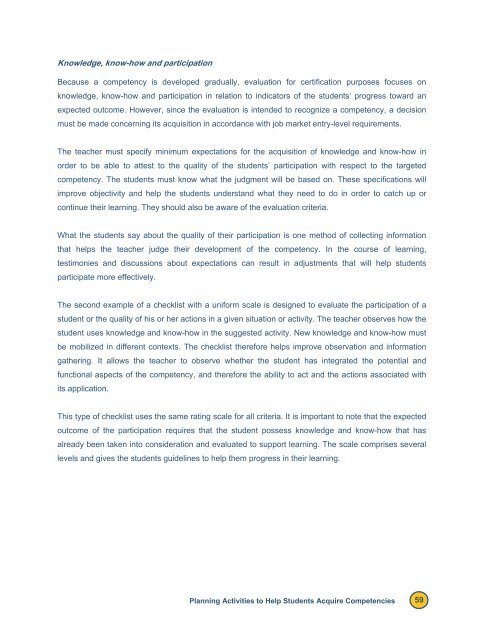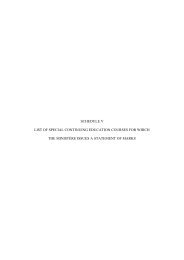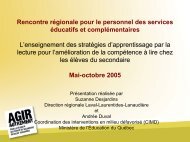Reference Framework for Planning Learning and Evaluation Activities
Reference Framework for Planning Learning and Evaluation Activities
Reference Framework for Planning Learning and Evaluation Activities
Create successful ePaper yourself
Turn your PDF publications into a flip-book with our unique Google optimized e-Paper software.
Knowledge, know-how <strong>and</strong> participation<br />
Because a competency is developed gradually, evaluation <strong>for</strong> certification purposes focuses on<br />
knowledge, know-how <strong>and</strong> participation in relation to indicators of the students’ progress toward an<br />
expected outcome. However, since the evaluation is intended to recognize a competency, a decision<br />
must be made concerning its acquisition in accordance with job market entry-level requirements.<br />
The teacher must specify minimum expectations <strong>for</strong> the acquisition of knowledge <strong>and</strong> know-how in<br />
order to be able to attest to the quality of the students’ participation with respect to the targeted<br />
competency. The students must know what the judgment will be based on. These specifications will<br />
improve objectivity <strong>and</strong> help the students underst<strong>and</strong> what they need to do in order to catch up or<br />
continue their learning. They should also be aware of the evaluation criteria.<br />
What the students say about the quality of their participation is one method of collecting in<strong>for</strong>mation<br />
that helps the teacher judge their development of the competency. In the course of learning,<br />
testimonies <strong>and</strong> discussions about expectations can result in adjustments that will help students<br />
participate more effectively.<br />
The second example of a checklist with a uni<strong>for</strong>m scale is designed to evaluate the participation of a<br />
student or the quality of his or her actions in a given situation or activity. The teacher observes how the<br />
student uses knowledge <strong>and</strong> know-how in the suggested activity. New knowledge <strong>and</strong> know-how must<br />
be mobilized in different contexts. The checklist there<strong>for</strong>e helps improve observation <strong>and</strong> in<strong>for</strong>mation<br />
gathering. It allows the teacher to observe whether the student has integrated the potential <strong>and</strong><br />
functional aspects of the competency, <strong>and</strong> there<strong>for</strong>e the ability to act <strong>and</strong> the actions associated with<br />
its application.<br />
This type of checklist uses the same rating scale <strong>for</strong> all criteria. It is important to note that the expected<br />
outcome of the participation requires that the student possess knowledge <strong>and</strong> know-how that has<br />
already been taken into consideration <strong>and</strong> evaluated to support learning. The scale comprises several<br />
levels <strong>and</strong> gives the students guidelines to help them progress in their learning.<br />
<strong>Planning</strong> <strong>Activities</strong> to Help Students Acquire Competencies 59




